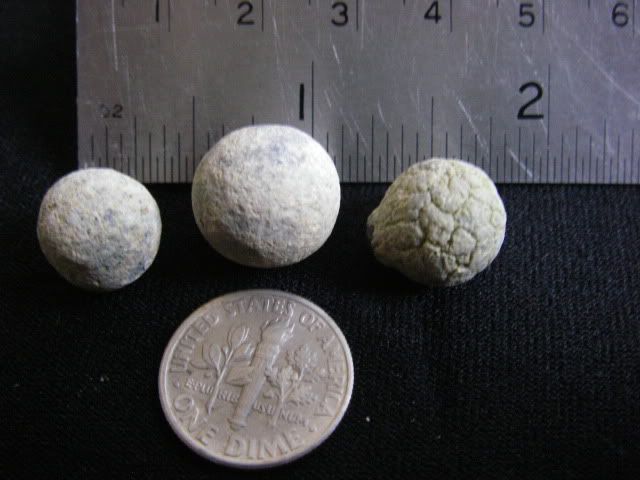Many moulds for bullets caste both conical and round bullets and round ones are certainly not uncommon. What was the date of the scow? Some one mentioned grapeshot and that is not a silly suggestion either as it is quite feasible for them to indeed be grapeshot - the earliest scows may have carried a cannon or two but more likely a carronade if anything or a signal gun or swivel gun. The later was placed on a mounting on the rail of the vessel and used for close range defence against boarders. If they came from a Spanish wreck on the Florida Keys you could say with 100% certainty that you had musket balls or grapeshot and the same if they came from say the Orpheus, Osprey or Boyd but from a scow...Hmm!
I have no idea though why any New Zealand scow would carry any gun for defensive reasons as the first scow made in New Zealand was the Lake Erie made in 1873 and the Maori Wars were by then over. It is vaguely possible that some skitterish ships master may have kept a small gun with grapeshot for defensive purposes just in case trouble arose but somehow I dont think its likely - if I put myself into the place of a ships master I might have carried one to blast to Kingdom Come any crittur which squeaked, squawked or otherwise hiccuped, like an errant whale, shark, seal, sea lion or a sadly lost Walrus just as Captain Hamblin of the whaling vessel Eliza Adams spend his spare time when he wasnt chasing whales or hunting down deserters blasting shit out of an old brandy case with his Colt Patent revolver.
They are not percussion revolver balls as they are all too big - to be percussion revolver they would be around .44 caliber although the British did make Dragoon revolvers for use in areas where the natives worked themselves up into an Adrenaline frenzy prior to attacking and where an almighty Ummph was needed to bowl them. To this end they made 'Hand cannons' for lack of a better term!
Have a look at this gun -
http://www.firearmscolle...t/cat_details.asp?id=185Both Adams and Tranter made these Dragoon pistols in .38 bore or .50 caliber - these guns were rather large and cumbersome compared with even their .44 equivalent.
Your lead balls are not however for these guns as they are too large. They could conceivably be for a British single shot army or sea service type in either flintlock or percussion or private purchase single shot pistol - the smaller ball seems about right at maybe .62 cal while the larger one might be a musket one
This gun could well take the smaller ball
http://www.oldguns.co.uk/images/4024.jpgThis one might take the larger ball
http://www.oldguns.co.uk/images/2684.jpgThese pistols however were more or less obsolete during the days when scows ruled supreme but that does not mean that they were not used now and again by various men who owned them and still used them - these pistols were made obsolete by the invention of good quality reliable revolvers - in England the best were the Adams - his first good gun was the 1851 model revolver which was also used as the basis for the Tranters as there was a working relationship between Adams and Tranter. Indeed revolvers were already well and truly on the scene a quarter century prior to the first scow mad ein New Zealand and most gold miners in 1861 carried repeating pistols with the odd fellow who could not afford a revolver carrying a box lock single shot, boot leg pistol or other single shot weapon.
Adams and Tranters were the British equivalent to the American Colt and Remington revolvers, Colt especially and indeed the Adams revolver was in direct competition to Colt - Colt had a factory in England - and Adams were made under licence by the Massachusetts Arms Company in the US of A. The Southern States also purchased Adams and Tranters direct from England. Adams, Tranter and Colts were the best revolvers used on the Maori War battlefields.
If I had a musket I would have favoured conical minnie balls as they had a hollow base and would expand into the bore/rifling effectively sealing it. At the time this scow went ashore the firearms would have nealry all been rifled, the exceptions being shotguns. I would also have favoured conical bullets in my Adams or Tranter as they packed more punch but round balls were lighter and wasted less lead...if you missed!
Hope that all helps!
Edited by user Wednesday, 2 November 2011 10:25:08 PM(UTC)
| Reason: Not specified
















